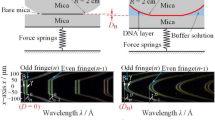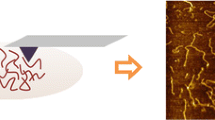Abstract
Four double-stranded DNA films with different chain lengths were prepared on 3-aminopropyltriethoxysilane (APS)-modified mica surfaces in the NaCl solution with concentration ranging from 0.001 to 0.1 M. By using an atomic force microscope, the force-distance curves and friction behaviour of each DNA film were studied in the NaCl solution that was used in the sample preparation. When adsorbed on mica as films in salt solution, the conformation of DNA molecules would be a combination of loops and “train-like”. As the chain length increased from 50 to 20000 bp, the extension rate of DNA film increased from 7.1 to 11.5 in 0.001 mol/L NaCl solution, which suggested that the DNA molecule with long chain likely resulted in more extended conformation. In addition, under low normal load, low NaCl concentration could increase the friction of DNA film and the chain length revealed insignificant effect on the friction force of DNA film. Therefore, long chain DNA with low salt concentration is more conducive to the nanopore sequencing process, since extended conformation can make DNA molecules easier to reach into nanopore and the high friction can reduce the translocation speed. These results may benefit the development of the third-generation sequencing technique based on nanopore.
Similar content being viewed by others
References
Watson J D, Crick F H C. A structure for deoxyribose nucleic acid. Nature, 1953, 171(2): 737–738
Taylor R W, Turnbull D M. Mitochondrial DNA mutations in human disease. Nat Rev Genet, 2005, 6(5): 389–402
Shendure J, Ji H. Next-generation DNA sequencing. Nat Biotechnol, 2008, 26(10): 1135–1145
Margulies M, Egholm M, Altman W E, et al. Genome sequencing in microfabricated high-density picolitre reactors. Nature, 2005, 437(7057): 376–380
Shendure J, Porreca G J, Reppas N B, et al. Accurate multiplex polony sequencing of an evolved bacterial genome. Science, 2005, 309(5741): 1728–1732
Schneider G F, Dekker C. DNA sequencing with nanopores. Nat Biotechnol, 2012, 30(4): 326–328
Manrao E A, Derrington I M, Laszlo A H, et al. Reading DNA at single-nucleotide resolution with a mutant MspA nanopore and phi29 DNA polymerase. Nat Biotechnol, 2012, 30(4): 349–354
Wells D B, Belkin M, Comer J, et al. Assessing graphene nanopores for sequencing DNA. Nano Lett, 2012, 12(8): 4117–4123
Lagerqvist J, Zwolak M, Ventra M D. Fast DNA sequencing via transverse electronic transport. Nano Lett, 2006, 6(4): 779–782
Fologea D, Gershow M, Ledden B, et al. Detecting single stranded DNA with a solid state nanopore. Nano Lett, 2005, 5(10): 1905–1909
Branton D, Deamer D W, Marziali A, et al. The potential and challenges of nanopore sequencing. Nat Biotechnol, 2008, 26(10): 1146–1153
Clausen-Schaumann H, Rief M, Tolksdorf C, et al. Mechanical stability of single DNA molecules. Biophys J, 2000, 78(4): 1997–2007
Cui S X, Yu J, Kühner F, et al. Double-stranded DNA dissociates into single strands when dragged into a poor solvent. J Am Chem Soc, 2007, 129(47): 14710–14716
Liu N N, Zhang W K. Feeling inter-or intramolecular interactions with the polymer chain as probe: Recent progress in SMFS studies on macromolecular interactions. Chem Phys Chem, 2012, 13(9): 2238–2256
Rhee M, Burns M A. Nanopore sequencing technology: nanopore preparations. Trends Biotechnol, 2007, 25(4): 174–181
Lyubchenko Y, Shlyakhtenko L, Harrington R, et al. Atomic force microscopy of long DNA: Imaging in air and under water. Proc Natl Acad Sci USA, 1993, 90(6): 2137–2140
Xu M S, Endres R G, Tsukamoto S, et al. Conformation and local environment dependent conductance of DNA molecules. Small, 2005, 1(12): 1168–1172
Qian L M, Tian F, Xiao X D. Tribological properties of self-assembled monolayers and their substrates under various humid environments. Tribol Lett, 2003, 15(3): 169–176
Varenberg M, Etsion I, Halperin G. An improved wedge calibration method for lateral force in atomic force microscopy. Rev Sci Instrum, 2003, 74(7): 3362–3367
Yu J X, Qian L M. An improved calibration method for friction force in atomic force microscopy. Tribology, 2007, 27(5): 472–476
Qian L M, Xiao X D. Tip in situ chemical modification and its effects on tribological measurements. Langmuir, 2000, 16(2): 662–670
Chen L, Kim S H, Wang X D, et al. Running-in process of Si-SiOX/SiO2 pair at nanoscale-Sharp drops in friction and wear rate during initial cycles. Friction, 2013, 1(1): 81–91
Takashi K, Hiroyuki T, Norio M, et al. A new self-fabrication of large-scale deoxyribonucleic acid network. Jpn J Appl Phys, 2000, 39(4A): 269–270
Cui S X, Zhang W K, Xu Q B, et al. Supramolecular research by single molecule force spectroscopy. Macromolecular Symposia, 2003, 195(1): 109–114
Saenger W, Hunter W N, Kennard O. DNA conformation is determined by economics in the hydration of phosphate groups. Nature, 1986, 324(6095): 385–388
Butt H J. Measuring electrostatic, van der Waals, and hydration forces in electrolyte solutions with an atomic force microscope. Biophys J, 1991, 60(6): 1438–1444
Wang M, Tian Y, Cui S X, et al. Effect of salt concentration on the conformation and friction behaviour of DNA. Colloid Surface A, 2013, 436: 775–781
Butt H J, Kappl M, Mueller H, et al. Steric force measured with the atomic force microscope at various temperatures. Langmuir, 1999, 15(7): 2559–2565
Oncins G, Manyes S G, Sanz F. Study of frictional properties of a phospholipid bilayer in a liquid environment with lateral force microscopy as a function of NaCl concentration. Langmuir, 2005, 21(16): 7373–7379
Xiao X D, Qian L M. Investigation of humidity-dependent capillary force. Langmuir, 2000, 16(21): 8153–8158
Chen L, Yang M C, Yu J X, et al. Nanofretting behaviours of ultrathin DLC coating on Si(100) substrate. Wear, 2011, 271(9): 1980–1986
Keyser U F, Koeleman B N, Dorp S V, et al. Direct force measurements on DNA in a solid-state nanopore. Nat Phys, 2006, 2(7): 473–477
Author information
Authors and Affiliations
Corresponding author
Rights and permissions
About this article
Cite this article
Wang, M., Cui, S., Yu, B. et al. Effect of chain length on the conformation and friction behaviour of DNA. Sci. China Technol. Sci. 56, 2927–2933 (2013). https://doi.org/10.1007/s11431-013-5406-z
Received:
Accepted:
Published:
Issue Date:
DOI: https://doi.org/10.1007/s11431-013-5406-z




